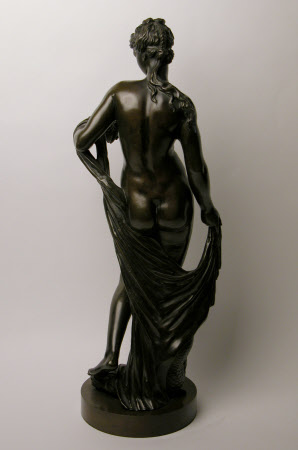Figure of Amphitrite
after Michel Anguier (Eu c.1612 - Paris 1686)
Category
Art / Sculpture
Date
c. 1850 - 1900
Materials
Bronze and wood
Measurements
565 mm High (180 mm diameter) (24 1/4 in) High
Place of origin
Paris
Order this imageCollection
Hatchlands Park, Surrey
NT 1166752
Summary
Sculpture, bronze; Amphitrite; after a model by Michel Anguier (1612/14- 1686); Paris, France, model c. 1652, cast c. 1850-1900. A bronze figure of Amphitrite, wife of the sea god Neptune, showing her standing with a crayfish in her hand and a dolphin at her feet. A late cast of a figure that formed part of a series of seven gods and goddesses made by Michel Anguier in around 1652, after he had returned to France after several years living in Rome.
Full description
A bronze figure of Amphitrite, wife of Neptune, god of the sea. Amphitrite is depicted standing, naked except for a swag of drapery sweeping round behind her and seeming to frame her figure. She gently holds in her left hand a crustacean, probably a crayfish, whilst to her right, a dolphin’s head is partly covered by the drapery, the animal looking out from between Amphitrite’s legs. Attached by screws to a separately cast plain circular base. Amphitrite was a sea nymph, the spouse of Neptune, god of the sea. In this exceptionally graceful composition, she appears absorbed in her contemplation of the crustacean held in her left hand, whilst a dolphin peeks beadily out at us from beneath the swirls of drapery. The flattening of the composition when seen from the side suggests that it is principally intended to be viewed frontally rather than in the round, but some of the most beautiful elements, the buttocks subtly revealed by the falling drapery and the cascade of falling hair, only fully visible from the back. Michel Anguier and his brother, François, came from Normandy but trained in Paris before travelling to Rome, where Michel worked for the leading sculptors in the city, Alessandro Algardi and Gianlorenzo Bernini. In 1651 Michel Anguier returned to France, where he was henceforth employed on major projects that included the decoration of queen Anne of Austria’s apartments in the Louvre and the decoration of the Church of Val-de-Grâce in Paris. His famous series of bronze figures of gods and goddesses was conceived as early as 1652, immediately following his return to France, and became highly influential (for further discussion of the series and its reception, see discussion of the example at Anglesey Abbey, NT 515055; see also Bresc-Bautier, Scherf and Draper 2009, pp. 204-225, nos. 55-62, the Amphitrite no. 55 and Warren 2010, pp. 138-57, nos. 12-13, the Amphitrite no. 12). Anguier seems to have planned three series of pairs of divine spouses: Jupiter and Juno; Neptune and Amphitrite; Pluto and Ceres. There is also a seventh figure of Mars, which seems to have been paired with a Hercules. Anguier consciously sought in his first three pairs of figures to represent contrasting emotions. In the Neptune and Amphitrite, perhaps the most compositionally interesting of them all, an ‘agitated’ and dynamic figure of Neptune is contrasted with the elegant figure of the ‘tranquil’ Amphitrite, engaged in contemplation of the crayfish held in her hand. Amphitrite’s pose is based on a famous antique statue, the draped figure of the Farnese Flora , but also shows awareness of Renaissance prototypes. The elegant Amphitrite was by far the most successful of all Anguier’s gods and goddesses, appealing to collectors from the time it was made. Full-size copies were made in stone, whilst the bronze figures are known in three sizes, a larger prime version (c. 53 cm.), medium-sized (c. 37 cm.) and small (c. 27 cm.) versions. The medium-sized version is often, for example in the pair at Anglesey Abbey, found paired with a bronze of Bacchus, the model of which is attributed to Louis Garnier (c. 1639-1728). A routine and mechanical cast, probably dating from the second half of the nineteenth century, the Hatchlands Amphitrite demonstrates the continuing popularity of this beautiful figure. The largest size of the bronze versions, it is one of no fewer than five casts of the model in National Trust collections, of different sizes and materials. The best is the medium-sized bronze version at Anglesey Abbey, paired with its figure of Bacchus (NT 515055-515056), which was probably cast in the late seventeenth century; there is a small example at Polesden Lacey (NT 1246218, paired with an unrelated Shepherd), whilst other larger-size bronze versions are at Saltram (NT 871606.2; also paired with the Shepherd) and at Tatton Park (NT 1297758; paired with Michel Anguier’s Mars). Finally there is a life-size stone Amphitrite in the garden at Hinton Ampner (NT 1530165). Jeremy Warren May 2023
Provenance
Harry Stuart Goodhart-Rendel (1887-1959); given to the National Trust at an unknown date.
Makers and roles
after Michel Anguier (Eu c.1612 - Paris 1686), sculptor French School or Italian School, sculptor
References
Bresc-Bautier, Scherf and Draper 2009: Geneviève Bresc-Bautier, Guilhem Scherf and James David Draper (eds.), Cast in Bronze: French Sculpture from Renaissance to Revolution, exh. cat., Metropolitan Museum of Art, New York, Paris 2009, no. 55. Warren 2010: Jeremy Warren, Beauty and Power. Renaissance and Baroque Bronzes from the Peter Marino Collection, exh. cat., Wallace Collection, London 2010, no. 12.

